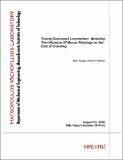| dc.contributor.author | Lauga, Eric | |
| dc.contributor.author | Hosoi, A.E. | |
| dc.date.accessioned | 2007-05-04T18:15:06Z | |
| dc.date.available | 2007-05-04T18:15:06Z | |
| dc.date.issued | 2007-05-04T18:15:06Z | |
| dc.identifier.uri | http://hdl.handle.net/1721.1/37326 | |
| dc.description | Submitted to Phys. Fluids. | en |
| dc.description.abstract | Common gastropods such as snails crawl on a solid substrate by propagating muscular waves of shear stress on a viscoelastic mucus. Producing the mucus accounts for the largest component in the gastropod’s energy budget, more than twenty times the amount of mechanical work used in crawling. Using a simple mechanical model, we show that the shear-thinnning properties of the mucus favor
a decrease in the amount of mucus necessary for crawling, thereby decreasing the overall energetic cost of locomotion. | en |
| dc.description.sponsorship | NSF and Hock Tan Postdoctoral Fellowship | en |
| dc.language.iso | en_US | en |
| dc.relation.ispartofseries | 06-P-02 | en |
| dc.subject | Gastropod locomotion | en |
| dc.subject | Optimization | en |
| dc.subject | Rheology | en |
| dc.subject | Snails | en |
| dc.title | Tuning Gastropod Locomotion: Modeling The Influence Of Mucus Rheology on the Cost of Crawling | en |
| dc.type | Preprint | en |
